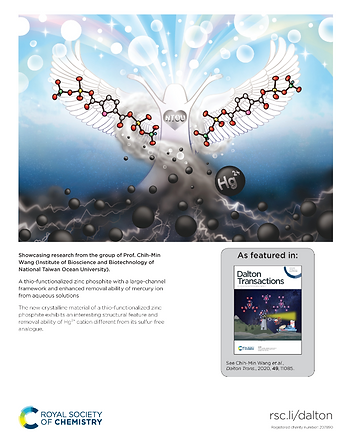top of page

Solid State Chemistry Laboratory for Inorganic-Organic Hybrid Materials and Their Applications
王志銘 教授
Professor. Chih-Min Wang

國立臺灣海洋大學教授 (2022 ─ NOW)
國立臺灣海洋大學副教授 (2019 ─2022)
國立臺灣海洋大學助理教授 (2015─2019)
科技部/國立中央大學助理研究學者 (2010─2015)
中央研究院/國立中央大學博士後研究 (2009─2010)
中央研究院國防科技役研究助理 (2003─2009)
研究室項目簡介
An introduction to our lab
我們實驗室主要從事新型結晶材料設計與合成方面的研究,因為它們具有豐富的結構化學特性與潛在的應用,包括發光性質、環境保護及能源相關等議題的研究。
材料的結構決定他們的性質表現,因此,我們致力於合成和設計具有新型結構與奈米結構框架的固態材料,並且研究它們的物理化學特性及探討可能的應用性。在水熱或溶劑熱的合成條件下,搭配適當的金屬陽離子、無機基團及有機分子當作模板或配位基以自我組裝的方式合成化合物。同時,我們也藉由實驗室的專業知識及經驗進行跨領域研究 (合作對象有中研院化學所呂光烈、涂熊林與郭俊宏研究員)。

實驗室獲選封面期刊之研究
最新研究
A thio-functionalized zinc phosphite with a large-channel framework and enhanced removal ability of mercury ion from aqueous solutions
Dalton Transactions - 2020 DOI: 10.1039/D0DT02270E

The first example of a thio-functionalized zincophosphite material (NTOU-2S) incorporating the 2,5-thiophenedicarboxylate (TPDC) ligands was synthesized using a hydro(solvo)thermal method and structurally characterized by single-crystal X-ray diffraction. Interestingly, the perspective view of the crystal structure for NTOU-2S is similar to our previous report of NTOU-2 but the carboxylate organic ligands (TPDC for NTOU-2S; 1,4-benzenedicarboxylate, BDC, for NTOU-2) in both compounds adopt different types of bis-monodentate coordination models (the unusual cis bonding versus a trans linkage) to bridge the metal atoms of inorganic tubes in the formation of large-channel zincophosphite frameworks, resulting in structural and functional diversities. The thiophene-based compound also displayed higher thermal stability and removal ability for the softer Hg2+ cations from water solutions than the performance of sulfur-free NTOU-2. In addition, the synthesis, structural characteristics, removal properties of heavy metal cations, and thermal and chemical stabilities for both compounds were also reported.
Zinc(II)–Organic Framework Films with Thermochromic and Solvatochromic Applications
L.-W. Lee, H.-Y. Chi, Y.-C. Kao, T.-H. Hung, D.-S. Chiou, G.-H. Lee, S.-M. Peng, D.-Y. Kang, C.-M. Wang, K.-L. Lu
Chemistry – A European Journal DOI: https://doi.org/10.1002/chem.201905719
Multiple‐stimuli‐responsive photoluminescence films based on a ZnII–organic framework, {[Zn2(Htpim)(3,4‐pydc)2]⋅4 DMF⋅4 H2O}n (1, Htpim=2,4,5‐tri(4‐pyridyl)imidazole, 3,4‐H2pydc=3,4‐pyridinedicarboxylic acid), were fabricated. This compound consisted of a 2D corrugated layer, {Zn(3,4‐pydc)}n, which was further pillared using a Y‐shaped pillar N‐donor ligand (Htpim) to form a 3D‐pillared‐layer framework with 1D open channels. The rectangular channels in the as‐synthesized compound are fully occupied by guest DMF and H2O molecules. The framework exhibits instant and reversible thermochromic properties corresponding to the removal of different H2O and DMF guest molecules as temperature increases. The pale‐yellow crystal undergoes significant redshifting to a greenish emission centered at 530 nm. Compound 1 also showed remarkable solvatochromic effects in the presence of various organic solvents without affecting its structural integrity. In addition, polycrystalline MOF films were grown on an α‐Al2O3 support for switchable and fast‐response thermochromic and solvatochromic sensors.
A dual fluorescent/phosphorescent zincophosphite with interesting water adsorption and structural transformation properties
Chuan Chen, Chia-Fang Hsieh, Hsiu-Mei Lin, Ying-Feng Hsu, Jye-Shane Yang and Chih-Min Wang
Dalton Transactions - 2020 DOI: 10.1039/C9DT02288K
A dual fluorescent/phosphorescent solid was produced using the triazole-assisted synthesis method under hydro(solvo)thermal conditions. The title compound emitted blue luminescence that turned green when UV irradiation was stopped. It also exhibited stable PL properties with good thermal and photostability. Furthermore, the 3D inorganic skeleton in NTOU-6 underwent structural transformation into another inorganic metallophosphite solid (NTOU-6b) and water adsorption was observed during this process of structural reconstruction. The detailed structural features of both compounds were also determined by single-crystal X-ray diffraction. This is a very rare example of a metallophosphite with the interesting properties of luminescence color switching (blue to green), water adsorption, and structural transformation. The synthesis, structural diversity, adsorption, material stability, and luminescence properties were also discussed.
Dalton Transactions - 2020 DOI: 10.1039/D0DT02270E
Dalton Transactions - 2020, 08 DOI: 10.1039/d0dt02270e
Abstract
The first example of a thio-functionalized zincophosphite material (NTOU-2S) incorporating the 2,5-thiophenedicarboxylate (TPDC) ligands was synthesized using a hydro(solvo)thermal method and structurally characterized by single-crystal X-ray diffraction. Interestingly, the perspective view of the crystal structure for NTOU-2S is similar to our previous report of NTOU-2 but the carboxylate organic ligands (TPDC for NTOU-2S; 1,4-benzenedicarboxylate, BDC, for NTOU-2) in both compounds adopt different types of bis-monodentate coordination models (the unusual cis bonding versus a trans linkage) to bridge the metal atoms of inorganic tubes in the formation of large-channel zincophosphite frameworks, resulting in structural and functional diversities. The thiophene-based compound also displayed higher thermal stability and removal ability for the softer Hg2+ cations from water solutions than the performance of sulfur-free NTOU-2. In addition, the synthesis, structural characteristics, removal properties of heavy metal cations, and thermal and chemical stabilities for both compounds were also reported.

Highly Sensitive Detection of Mercury Ions Using Zincophosphite Framework Nanoparticle–Polyaniline Composites
ACS Appl. Nano Mater. 2020, 3, 10, 9724–9730 DOI:10.1021/acsanm.0c01837

Abstract
This study reports a highly sensitive mercury ion sensor composed of the zincophosphite framework nanoparticle (NTOU4nano) blended with in situ synthesized conductive polyaniline (PANI). High stability of the pristine zincophosphite solid not only renders a facile nanosizing treatment feasible but also allows it to withstand the electrochemical PANI deposition at a low pH condition. PANI significantly enhances the surface coverage concentration and increases the electron transfer capability of the resulting composite. Cyclic voltammetry (CV), differential pulse voltammetry (DPV), hydrodynamic amperometry, and electrochemical impedance spectroscopy (EIS) are used to characterize and optimize the electroanalytical performance of the nanocomposite. The resulting electrochemical sensor shows a linear dynamic range for mercury ion detection ranging from 0.05 to 27.5 nM and exhibits one of the lowest limits of detection (LODs) of 3.49 × 10–11 M reported using crystalline organic–inorganic hybrids. Additionally, the practical utility of the nanocomposite for mercury ion sensing is demonstrated using water samples containing high salt concentrations, as well as from the environment including the seawater and river water. In short, the reported nanocomposite is among one of the first metallophosphite materials being consolidated with PANI as an integrated sensing platform for highly sensitive mercury ion detection and holds good promise for early-warning application.
Zinc(II)–Organic Framework Films with Thermochromic and Solvatochromic Applications
Chemistry – A European Journal-2020 DOI: 10.1002/chem.201905719
Abstract
Multiple‐stimuli‐responsive photoluminescence films based on a ZnII–organic framework, {[Zn2(Htpim)(3,4‐pydc)2]⋅4 DMF⋅4 H2O}n (1, Htpim=2,4,5‐tri(4‐pyridyl)imidazole, 3,4‐H2pydc=3,4‐pyridinedicarboxylic acid), were fabricated. This compound consisted of a 2D corrugated layer, {Zn(3,4‐pydc)}n, which was further pillared using a Y‐shaped pillar N‐donor ligand (Htpim) to form a 3D‐pillared‐layer framework with 1D open channels. The rectangular channels in the as‐synthesized compound are fully occupied by guest DMF and H2O molecules. The framework exhibits instant and reversible thermochromic properties corresponding to the removal of different H2O and DMF guest molecules as temperature increases. The pale‐yellow crystal undergoes significant redshifting to a greenish emission centered at 530 nm. Compound 1 also showed remarkable solvatochromic effects in the presence of various organic solvents without affecting its structural integrity. In addition, polycrystalline MOF films were grown on an α‐Al2O3 support for switchable and fast‐response thermochromic and solvatochromic sensors.
%E2%80%93Organic%20Framework%20Films%20with%20Th.png)
An Unprecedented Interpenetrating Structure Built from Two Differently Bonded Frameworks: Synthesis, Characteristics, and Efficient Removal of Anionic Dyes from Aqueous Solutions
Chemistry – A European Journal-01 April 2019 DOI: 10.1002/chem.201900607
Abstract
The first example of one single crystal (NTOU‐5) containing two different organic‐inorganic hybrid open‐framework structures was obtained using a hydro(solvo)thermal method and structurally characterized by single‐crystal X‐ray diffraction. Remarkably, under the same synthetic conditions, the zinc ions are respectively coordinated by oxalic acid (OX) and 1,2,4,5‐tetrakis(imidazol‐1‐ylmethyl)benzene (TIMB) linkers to form two significantly different frameworks: anionic [Zn2(OX)3]2− and cationic [Zn(TIMB)]2+ networks that interweave with each other to give an unprecedented interpenetrating structure with two differently‐bonded open‐frameworks. From the inorganic chemistry perspective, it is extremely difficult to control to which metal center the oxygen‐donor linkers or/and nitrogen‐donor ligands bind. A mixed Co/Zn analogue was also obtained by a similar method. The single‐crystal XRD and EDS analyses indicate that the octahedral Zn ions of the anionic framework are replaced by cobalt cations, whereas the Zn ions in the tetrahedral positions of the cationic networks remain intact. This leads to the formation of the interpenetrating analogue with a mixed metal composition. Furthermore, NTOU‐5 shows structural stability and efficiently removes organic dyes from aqueous solutions at concentrations of 10 ppm.

A dual fluorescent/phosphorescent zincophosphite with interesting water adsorption and structural transformation properties
Dalton Transactions - 2019 DOI: 10.1039/C9DT02288K

Abstract
A dual fluorescent/phosphorescent solid was produced using the triazole-assisted synthesis method under hydro(solvo)thermal conditions. The title compound emitted blue luminescence that turned green when UV irradiation was stopped. It also exhibited stable PL properties with good thermal and photostability. Furthermore, the 3D inorganic skeleton in NTOU-6 underwent structural transformation into another inorganic metallophosphite solid (NTOU-6b) and water adsorption was observed during this process of structural reconstruction. The detailed structural features of both compounds were also determined by single-crystal X-ray diffraction. This is a very rare example of a metallophosphite with the interesting properties of luminescence color switching (blue to green), water adsorption, and structural transformation. The synthesis, structural diversity, adsorption, material stability, and luminescence properties were also discussed.
A Highly Stable Framework of Crystalline Zinc Phosphite with Selective Removal, Recovery, and Turn‐On Sensing Abilities for Mercury Cations in Aqueous Solutions
Chemistry – A European Journal 2018 DOI: 10.1002/chem.201802455
Abstract
A highly stable framework of organic‐inorganic hybrid zinc phosphite (NTOU‐4) and its cobalt analogue (NTOU‐4a) were synthesized under the hydro(solvo)thermal conditions and structurally characterized by single‐crystal X‐ray diffraction. Their frameworks consisted of inorganic metallophosphite chains, in which the metal atoms were interlinked through 1H‐1,2,4‐triazole‐3,5‐diamine and 1,4‐benzenedicarboxylate linkers to form new crystalline materials. It is extremely difficult to achieve the consolidation of three distinct coordinations of metal‐carboxylate, metal‐triazolate, and metal‐phosphite bonds into one crystal, resulting in the synthesis of the first mixed‐ligand terephthalate‐metallophosphite solids in the absence of organic molecules as templates or space‐filling counters in their structures. Interestingly, the zinc compound not only exhibits high thermal stability (up to 400 °C in air) and chemical resistance to seawater, aqueous solutions (pH 3–11), and organic solvents at boiling conditions, but also shows selective removal, recovery, and “turn‐on” sensing abilities of toxic mercury ions in aqueous solutions. Furthermore, the synthesis, characterization, and the difference of the framework stabilities between isostructural zinc and cobalt compounds are also reported.

New 3D Tubular Porous Structure of an Organic–Zincophosphite Framework with Interesting Gas Adsorption and Luminescence Properties
Chemistry – A European Journal 2016 DOI:10.1002/chem.201602918
Abstract
A new 3D tubular zinc phosphite, Zn2(C22H22N8)0.5(HPO3)2⋅H2O (1), incorporating a tetradentate organic ligand was synthesized under hydro(solvo)thermal conditions and structurally characterized by single‐crystal X‐ray diffraction. Compound 1 is the first example of inorganic zincophosphite chains being interlinked through 1,2,4,5‐tetrakis(imidazol‐1‐ylmethyl)benzene to form a tubular porous framework with unusual organic–inorganic hybrid channels. The thermal and chemical stabilities, high capacity for CO2 adsorption compared to that for N2 adsorption, and interesting optical properties of LED devices fabricated using this compound were also studied.

A thio-functionalized zinc phosphite with a large-channel framework and enhanced removal ability of mercury ion from aqueous solutions
bottom of page

